#romanias religion
Text
Religion
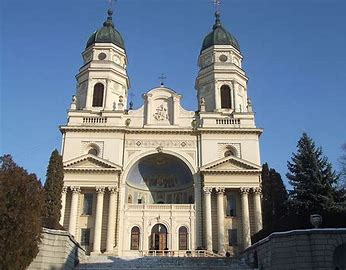
Here is a Religious church that is based in Romania but there are also monasteries all around as their religion is all over their country. Romania is one of the most religious European countries and the majority of the country's citizens are Orthodox Christians. Romania is one of the most religious European countries and the majority of the country's citizens are Orthodox Christians. Part of Romanians are Orthodox and some are partly Catholic too but there aren't many people that are protestants around Romania although there are many more religions. This church is based in Iasi Romania, this is one of the churches located in this place as there are many more.
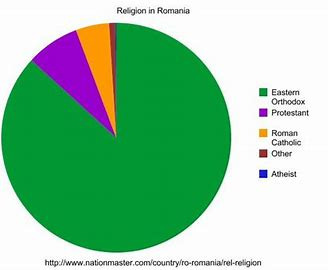
This is a pie chart to show all the different religions around Romanians to this day showing you exactly and accurately the amount.
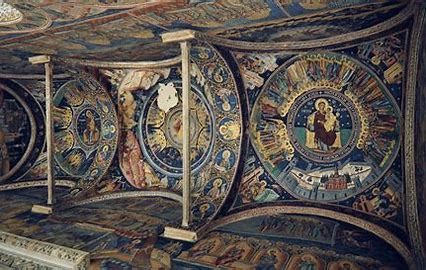
Paintings
These are traditional and religious paintings that Romania has in churches or Monestries, this is because this country is very religious and respects its culture deeply. These paintings are painted by priests. Few religious monuments are as inspirational and mesmerizing as Sucevita Monastery, one of the eight painted churches from Bucovina
Medieval History
The history of the monastery starts with the story of the Movila brothers, the great-grandsons of Moldavia’s most beloved prince, Stephen the Great. One of them, Gheorghe, converted to monastic life and eventually became the Metropolitan of Moldavia while the other two, Simeon and Ieremia, became princes of the same historical religion. The three brothers in the last two decades of the 16th century, this is the last church with painted exterior walls from the region.
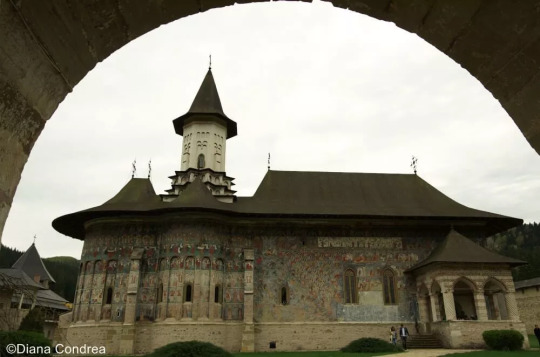
Cultures

The painted Easter eggs are the most colourful and loved part of this religious celebration in Romania. You’ll find them in every house, at every Easter meal, at church, and even at picnics. Their origin goes back at least a couple of centuries. People play games with them, they wait to see whose end of the egg cracked first and the one that doesn't crack both ends wins. Romanian artisans have transformed Easter eggs into unique works of art. The colours and symbols used to decorate the eggs vary according to the region, but three-four colours are constantly used. Red is love, black is eternity, yellow is youth and rich crops while green represents nature, and blue means health and sunny skies. The decorative motifs are also diverse, mixing symbols like the cross or the star with nature and animal representations. The use of symbols is also influenced by regional and local elements.
Alexander, G. (2021). Patriarch Daniel and The Resurgence of the Romanian Orthodox Church.
Constantin Iordachi (2022). The Fascist Faith of the Legion ‘Archangel Michael’ in Romania, 1927–1941. Taylor & Francis.
0 notes
Text
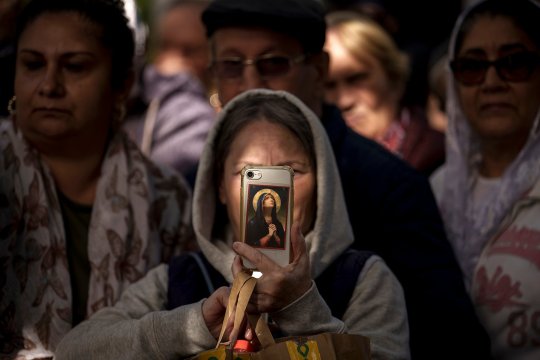
October 24, 2023: A woman takes pictures on a mobile phone as priests walk during procession for Saint Dimitrie Bassarabov, patron saint of the Romanian capital, in Bucharest, Romania. (AP Photo/Vadim Ghirda)
167 notes
·
View notes
Text

Moldovița Monastery (b. 1532), 2021
#picofthenight#travel#romania#original photographers#photographers on tumblr#ancient architecture#ancient art#religion#orthodox christianity#architecture#art#paintings#geometric shapes#photoofthenight
36 notes
·
View notes
Photo

Map of Protestantism & Restorationism in Romania
50 notes
·
View notes
Text
Every truth gives a feeling of liberation at the moment it is discovered; then it becomes a chain. The same can be said of a god; at the beginning, when one clings to it, one breathes, then one suffocates.
In all, only the beginning and the end deserve attention; both represent a moment of freedom: Doing and undoing, both are movements. The path towards being and the path out of being; that is “life,” that is freedom. But the state of being is a hindrance.
Notebooks
Emil Cioran
#emil cioran#theory#theology#philosophy#what changes is man#not god#religion#truth#romania#france#it is the image which suffocates
8 notes
·
View notes
Text

St Varlaam, Metropolitan of Moldavia, celebrated on August 30, 2023, at Secu Monastery, Romania, where he took his monastic vows. Photo credit: George Cristian
10 notes
·
View notes
Photo

Did you know:
The real Wallachia was incredibly unstable. I’ve stated in a previous post that Wallachia did not subscribe to the policy of ‘firstborn son succeeds father.’ No, they went by the rule of ‘any son, even if he’s illegitimate, can succeed the father.’ When the Prince of Wallachia died, his successor would be elected by the aristocratic boyars. So the ruling Prince dies, his successor is chosen from a small pool of candidates, Wallachia has a new monarch. Seems simple enough.
Here’s the problem: The dreaded Crusades were still going strong at this point in history. As a nation of predominantly Eastern Orthodox Christians, Wallachia declared their allegiances with the whole of Christian Europe and their nearest, most powerful ally was the Kingdom of Hungary, which sat northwest of Wallachia and Transylvania. However, right across the Danube River to the south was the Ottoman Empire, which boasted one of the strongest military forces in the world. Wallachia was about as on frontlines as you could get.
So during the Crusades, Wallachia joined up with Europe, often with disastrous results. Once the fighting stopped and all combatants went home, Wallachia was still stuck with Ottoman neighbors. And when the Sultan decided to expand the empire into Europe again…suddenly all Wallachia’s Christian allies, for a variety of reasons, essentially said, “Good luck.” So the Prince had to make nice with the Ottomans, often paying a ‘please don’t invade us’ tribute and would often be recruited into the Ottoman side of the war or would simply let the Ottoman army pass through Wallachia without resistance. At which point, the whole of Europe, namely Hungary, would see this, declare the Prince a traitor to Christ, finagle a way to depose him, instate another of the other candidates as a prince who was more sympathetic to the Christian agenda…and then whole thing would start all over again. And this went on for years, and that’s nothing to say on the political infighting. Namely, when one man was crowned, his brothers/cousins/any male relative in general, had a tendency to say, “Oh, hell no,” and allied themselves with either the Hungarians or the Ottomans in order to depose the current monarch.
In summary, Wallachia was a nation that was constantly trying to keep itself from being invaded, was constantly kicked around by both of its more powerful neighbors, and was the focal point of a lot of the off again, on again religious/territorial fighting.
Takeaway: This line by Trevor is way more accurate than it deserved to be.

#castlevania netflix#trevor belmont#historical post#historical context#wallachian politics and the history lesson no one asked for#medieval europe#medieval wallachia#wallachia#medieval romania#the ottoman empire#not trying to bash anyone's religion#atrocities were committed by all sides#castlevania#just let the little principality be#medieval europe was terrible#for a variety of reasons#political chaos#familial infighting
26 notes
·
View notes
Text
Hey wasn't it messed up when they would force you to stand up and pray in religion class and if you didn't you'd get in trouble
6 notes
·
View notes
Photo

Upcoming 2023 Orthodox Easter Romanian Photo Workshop Join me in the Maramures region of northern Romania 12-19 April 2023 for a week of enchantment during Orthodox Easter in one of the most traditional villages left in Europe. Details in the link in my profile or davinellicson.com/Workshops/Orthodox-Easter/1 #romania #easter #paste #maramures #photoworkshops #photoworkshop #documentaryphotography #reportage #davinellicson #romanian #orthodox #orthodoxeaster #workshops #easterneurope #religion #religious #rural #rurallife https://www.instagram.com/p/CpZzUlwIDZA/?igshid=NGJjMDIxMWI=
#romania#easter#paste#maramures#photoworkshops#photoworkshop#documentaryphotography#reportage#davinellicson#romanian#orthodox#orthodoxeaster#workshops#easterneurope#religion#religious#rural#rurallife
2 notes
·
View notes
Text
🦇Strigoi Night🦇
-November 30th-
“Listen to them—the children of the night. What music they make!” -Dracula

In Romania, November 30th has been held in folklore as a night in which vampires are said to be the most active and dangerous. In this, the end of November in Romania has come to resemble many aspects of Halloween. And so, on Strigoi Night, we celebrate the attributes and traits of the vampire and all they represent.
This holiday can be celebrated by:
feasting
merrymaking
throwing a vampire-themed party
watching a vampire film
communing with friends.
#vampire#vampirism#strigoi#Romania#Samhain#Samhainism#Halloween#halloween is my religion#eternal halloween#spooky#vampyre#vampyre culture#vamp#witch#witchcraft#witchery#witchy things#Halloween forever#folklore#religion#holiday
6 notes
·
View notes
Photo

#architecturephotography #sinagoga #bistrita #romania🇹🇩 #color #sinagogue #religion (la Sinagoga, Bistrița, Bistrița-Năsăud) https://www.instagram.com/p/ClcdddyII4s/?igshid=NGJjMDIxMWI=
1 note
·
View note
Text

Romanian Orthodox priests and believers stand outside the Patriarchal Cathedral after an Orthodox Palm Sunday pilgrimage in Bucharest, Romania, April 27, 2024. (AP Photo/Vadim Ghirda)
#religion#christianity#orthodoxy#romanian orthodox#christians#people#clergy#priests#holy week#palm sunday#romania#divinum-pacis
12 notes
·
View notes
Text



"Holy Trinity" Church (XVIII c.) - Sibiel, 2021
#picofthenight#travel#romania#original photographers#photographers on tumblr#ancient architecture#ancient church#frescoes#icons#interior photography#religion#christianity#photoofthenight
123 notes
·
View notes
Photo






Percentage of population in Romanian counties having the most common religions.
by Pe Cifre
42 notes
·
View notes
Text
I have little regard for someone who can easily do without Original Sin.
I admit that I resort to it in all circumstances in life and that without this idea I do not see how I would avoid a permanent stupor.
(Without the idea of Original Sin, amazement would be the only feeling granted to everything that happens and to everything that happens to us. This idea is an explanatory principle of universal value, which allows us to understand all the miseries which overwhelm us and mainly those which are linked to the fact of being man. Because whoever says man says Original Sin incarnate, current, more alive than ever. An initial scandal presides over our destinies, initial and inexhaustible …)
Notebooks
Emil Cioran
4 notes
·
View notes
Text

His Grace Benedict of Bistrița celebrated the Divine Liturgy at the patronal feast of the monastery founded by Holy Prince Neagoe Basarab at Curtea de Argeș, Romania, on September 26, 2023. Photo credit: Archdiocese of Argeș and Muscel
7 notes
·
View notes